Shooting a pistol accurately isn't easy. Tanner Denton
We may earn revenue from the products available on this page and participate in affiliate programs. Learn More ›
If you’re wondering how to shoot a pistol accurately, you’re not alone. Handguns are the most difficult firearms to shoot precisely. They’ve got short barrels, compact sight radiuses, and the guns themselves often aren’t built for top-notch accuracy. Most significantly, a handgun is subject to a lot more human input than a bipod-braced precision rifle—and every bit of that input hurts your accuracy.
Both new and seasoned shooters can struggle with handgun accuracy. Shooting a pistol accurately can mean many things depending on context, too. It might mean keeping your shots in the vital zone while running a Bill Drill with your concealed-carry pistol, or placing a clean shot on a deer at 100 yards with a scoped revolver. Virtually every definition of shooting a handgun accurately involves the same core fundamentals. If you can master those fundamentals, you’ll be able to shoot any type of handgun well.
The Fundamentals of Shooting a Pistol Accurately
In theory, it’s simple to shoot a pistol accurately. Line up the sights perfectly and squeeze the trigger without imparting any movement on the gun that will shift the muzzle off-course. Reality isn’t so simple, but there are some key things we can do to reduce our error and fire accurate shots. Our stance and shooting position, grip, sight picture, breathing cycle, trigger squeeze, and follow-through are critical components of an accurate shot.
Stance and Shooting Position
Your stance and shooting position are your foundation, especially when learning how to shoot a pistol accurately. Different shooting disciplines might dictate different positions, but the key is to establish a well-balanced, stable body position. Most folks just learning the craft of pistol shooting will shoot while standing—either a Weaver- or modern isosceles-style stance is usually best. Set your feet slightly wider than shoulder width, with your center of gravity a little forward to brace against recoil.
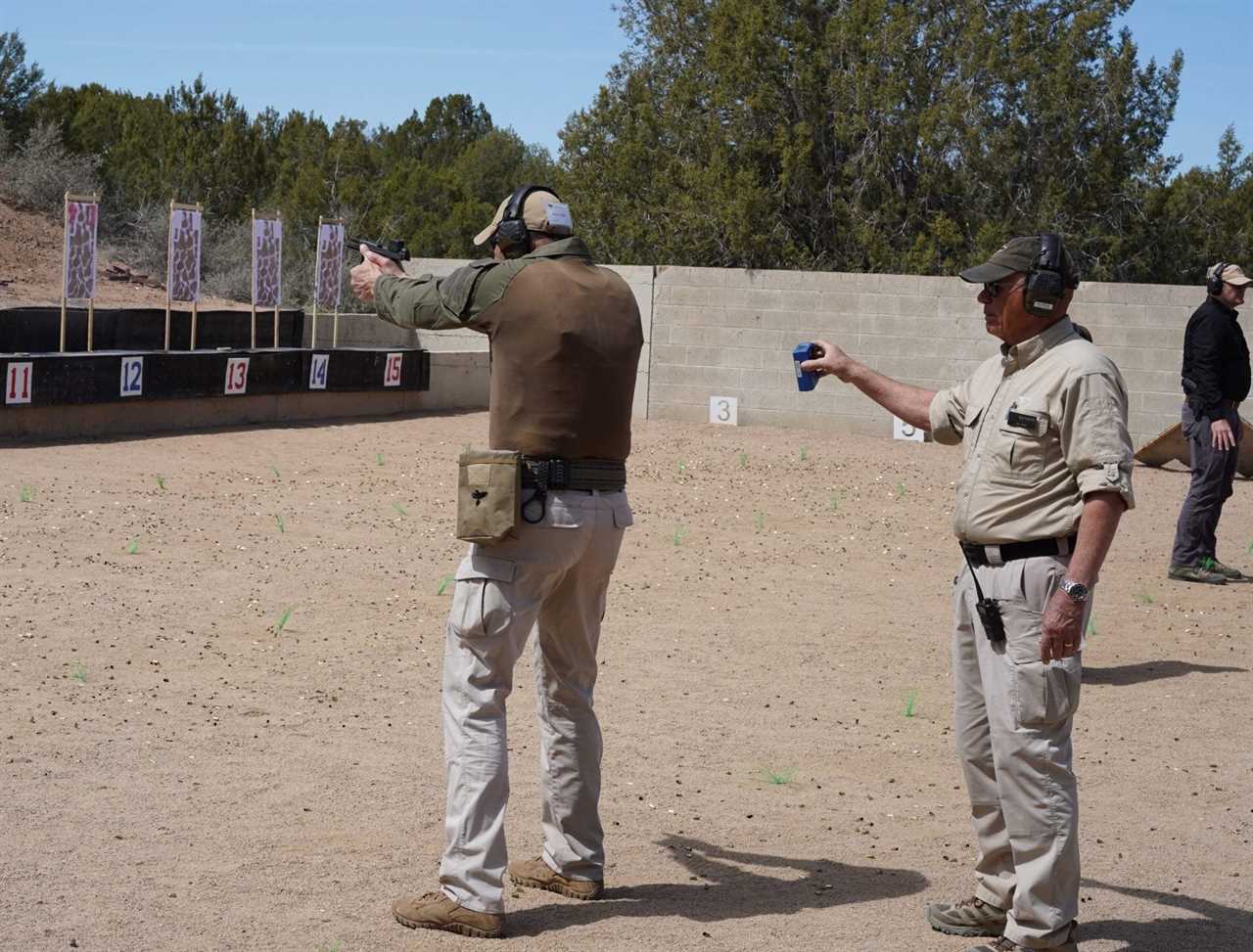
A student at Gunsite Academy demonstrates a stable shooting stance. Scott Einsmann
You don’t want to lean too far forward, but a common mistake for new shooters is to set the feet too close together and lean backward to counter the weight of the handgun being held out front. If you set a strong foundation, your body, and shot, will be much more stable. In an isosceles shooting stance, your feet will be square to the target, and you’ll extend both arms with elbows turned outward to reduce movement and counter recoil. The best shooting position will be slightly different for each person, but it will always be balanced and solid.
Gripping the Pistol
A proper grip is crucial for repeatable handgun accuracy, especially when firing more than one shot. Your grip is the interface between your body and the gun. It’s where you’ll either find stability or introduce error. A two-handed grip is the most consistent way to shoot a pistol accurately, but you’ll want to follow these same principles when shooting one-handed too:
- Set your grip as high as possible on the pistol
- Position your grip so that your wrist lines up behind the pistol
- Maximize contact with the gun
The most common mistake I witness shooters make with grip is setting it too low. When I see it, all I can hear in my head is a farmer-tanned little-league coach screaming, “Choke up on that thing kid! Grab it like you mean it!” The closer you can get your grip to the bore axis and sights, the more stable your sight picture, shot, and recoil management will be.
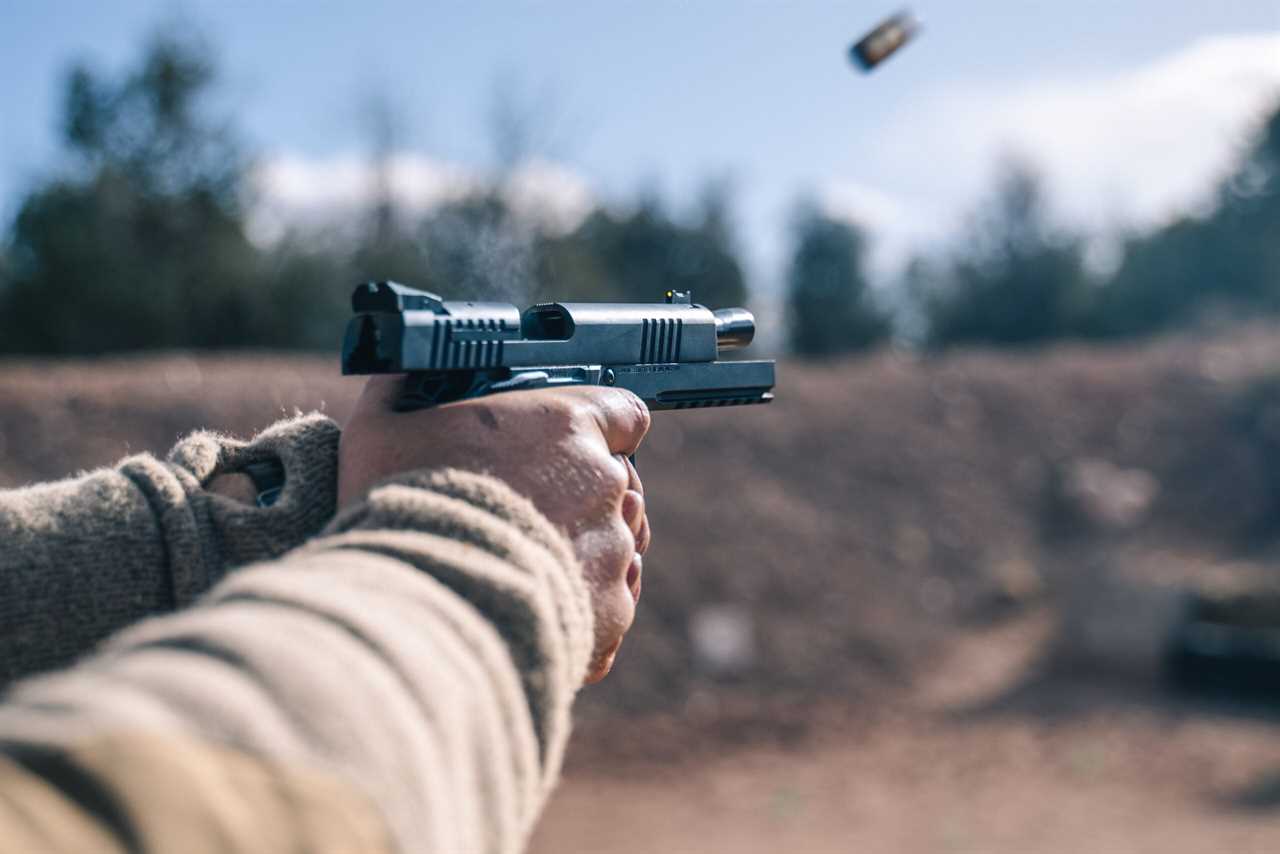
A high, tight grip on the pistol will help you achieve a more stable hold and resist recoil better. Tanner Denton
There are different schools of thought on the specifics of gripping a pistol with two hands, but most top-level shooters use a “stacked thumb” grip that maximizes contact with the gun. After getting a secure grip with the strong hand, the support hand fills in the gaps on the gun’s grip, and the support-hand thumb is often used to apply pressure to the pistol’s frame to stabilize it even more. You don’t need to have a deathgrip on the pistol, but a dainty grip is not an accurate grip.
Sight Picture
If you’re familiar with shooting iron sights on rifles, you know what your sight picture should look like on most pistols. On most pistols with iron sights, simply line up the front sight blade or dot in the notch, or between the dots of the rear sight. It’s important to center the front sight, by lining up the top of the front sight with the top of the rear and ensuring that it’s centered left-and-right too. You’ll find that it’s much more difficult to maintain your sight picture and be precise than with rifles, however. Any movement you introduce will throw the alignment of your front and rear sights off because of the short distance between the front and rear sights—known as the sight radius.
When shooting for accuracy, you want to keep your front sight in clear focus. This means that your rear sight and the target will be slightly blurry because you can only focus at one distance at a time. Most handgun sights are intended to have the bullet impact right at the top edge of where you’re holding the front sight. Sights on some defensive pistols—especially micro 9mm’s—are calibrated to have the bullet impact the spot that the front sight is covering up. Either way, focus on that front sight and keep your sights aligned to shoot precisely.
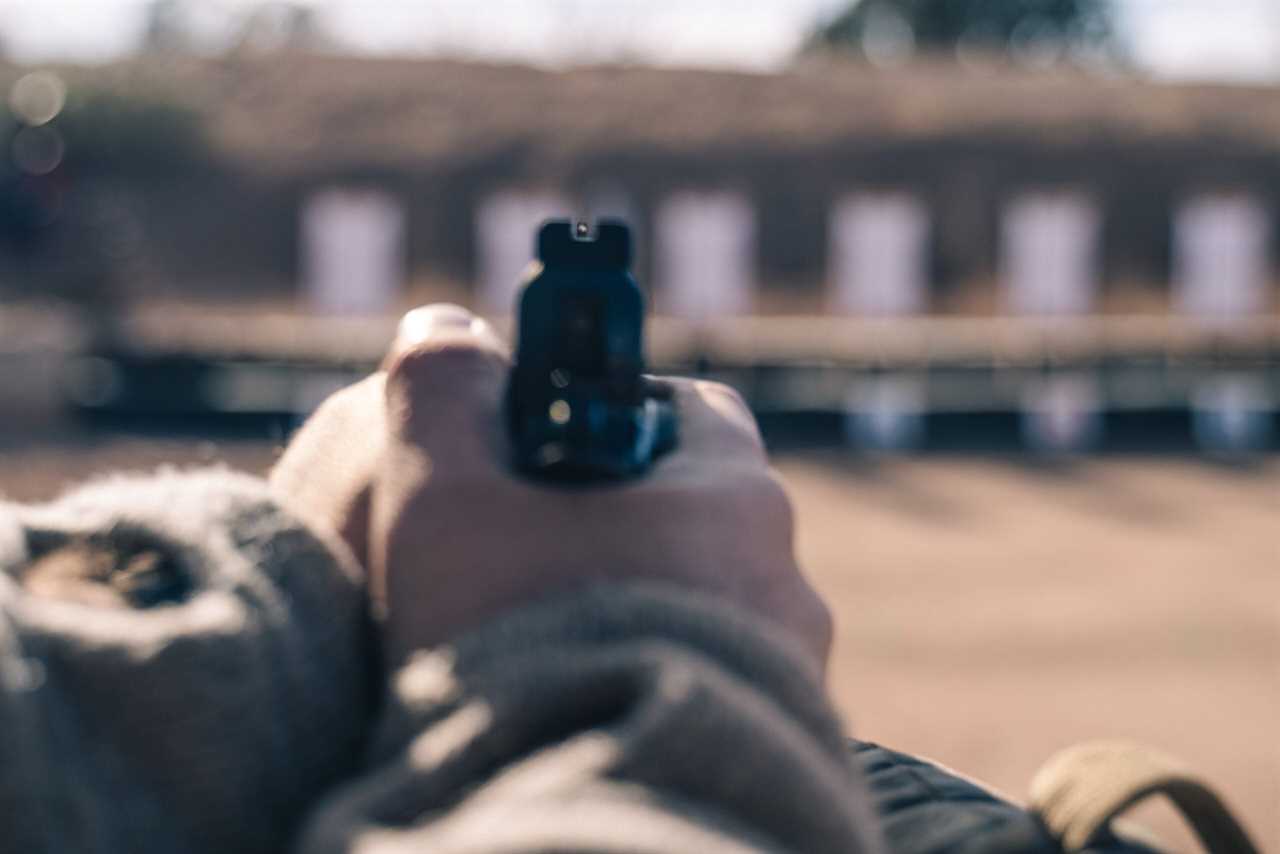
Good sight alignment is critical for shooting a pistol accurately. Tanner Denton
Red dot pistol optics can take some getting used to, but they are indisputably easier to shoot accurately than iron sights. With these, there’s no perfect sight alignment to be had. Simply put the red dot on the target and squeeze the trigger. Most manufacturers are offering optic-ready pistols now, so it’s a great option to consider.
Breathing Cycle
Like shooting a rifle or bow, your breathing cycle is critical when you’re trying to shoot a pistol accurately. The more movement you can eliminate from your body, the more accurately you’ll be able to shoot. A consistent breathing cycle not only helps reduce movement, it ensures that you’re firing your shot under repeatable conditions within your body and allows maximum focus at the right time.
If you’re going to fire a pistol for accuracy, Get into position and point at the target. Take a slow, deep breath, then exhale slowly, stopping your exhale about halfway through. This is when you fine-tune your aim and begin squeezing the trigger. The shot should break within three or four seconds of when you cut that breath off. Wait much longer and you can begin to lose focus as your body starts to use up the oxygen from that last breath. If you can’t get steady, just breathe and try again. Practicing this with dry-fire exercises is an excellent way to improve your accuracy.
Trigger Press
You’ve likely heard the old advice that your gun should surprise you when it goes off. I don’t really buy into that, but the truth that the adage scratches is that you shouldn’t ever jerk or pull the trigger quickly when shooting for accuracy. When shooting for speed, there’s a balance to be had, but for precision, you want to break the trigger over as cleanly and deliberately as possible.
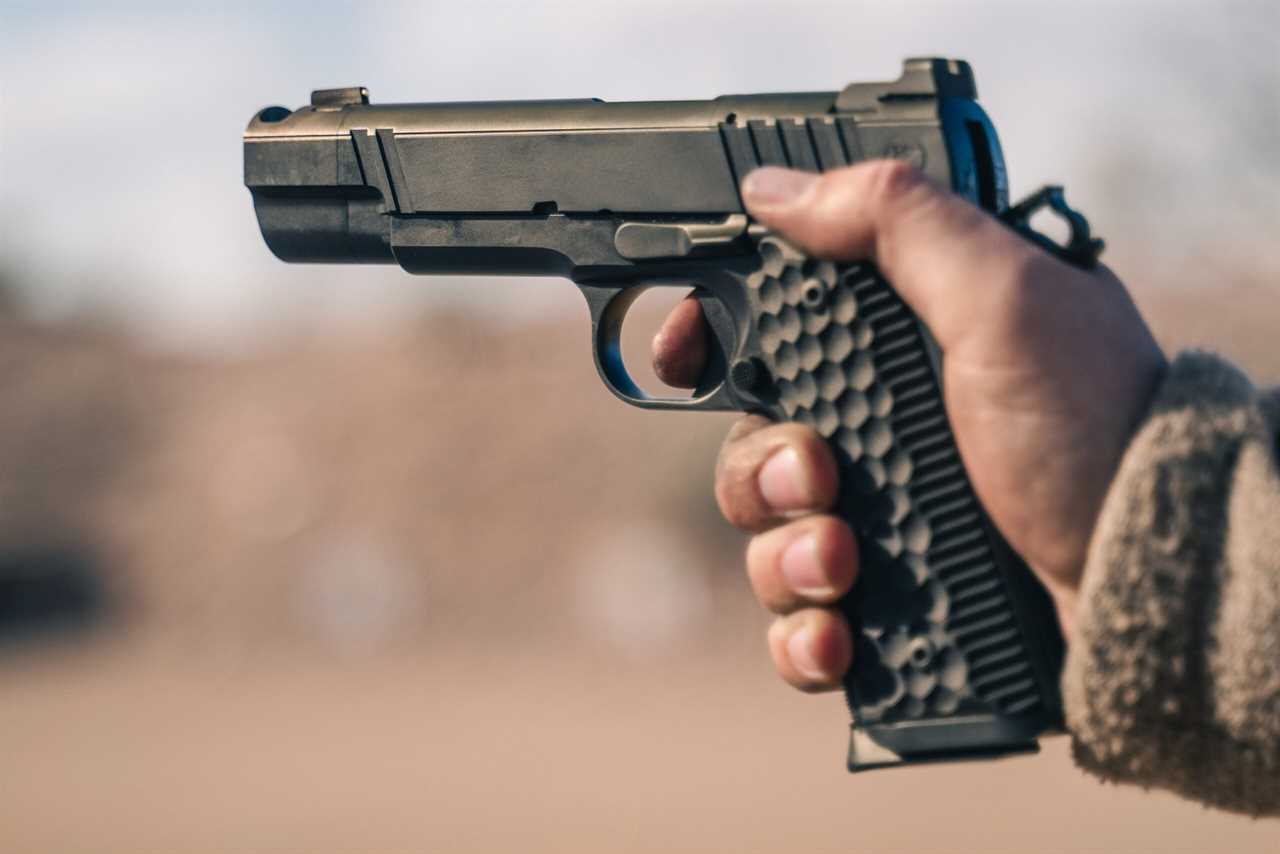
Your trigger press needs to be straight and smooth to shoot accurately. Tanner Denton
The trigger squeeze starts with your finger position on the trigger. Different shooters have different preferences, but you don’t want the very tip of your finger on the trigger, nor do you want your finger buried up to the last knuckle through the trigger guard. Usually the middle or inside of the first finger pad is a good place to set your finger on the trigger. You want your trigger pull to be straight back, and not impart any horizontal movement to the pistol.
Every pistol is different, but most pistols have some slop or slack in the trigger, and a hard wall before the break. Practice your trigger squeeze while dry firing, but a good way to shoot accurately is to take the slack out of the trigger once you’re on-target. At the right point in your breathing cycle, begin applying more pressure to the trigger, gently squeezing until it fires.
The Follow-Through
Just like throwing a baseball, the follow-through is an important part of handgun accuracy. What does following through mean when shooting a pistol? It means maintaining position as if the shot hadn’t been fired—or as if you are going to immediately fire another. Keep your grip tight and secure. Keep your focus on the sights or dot and watch them fall back onto target. Hold the trigger back, only to gently let it forward to the “click” of the reset after you’ve had a second to process the shot and how it felt.
One might argue that what happens after the bullet leaves the barrel doesn’t matter—and they’d be right. But the follow-through keeps the shooter from slipping up in the nanoseconds before you even finish pulling the trigger. Like a kid who doesn’t follow through on their pitch is holding back just a little bit of that proper execution, a shooter who doesn’t focus on following through is holding back too. If they aren’t focused on keeping the gun on target and holding that trigger squeeze right after the shot, that focus is likely starting to slip before said shot is fired.
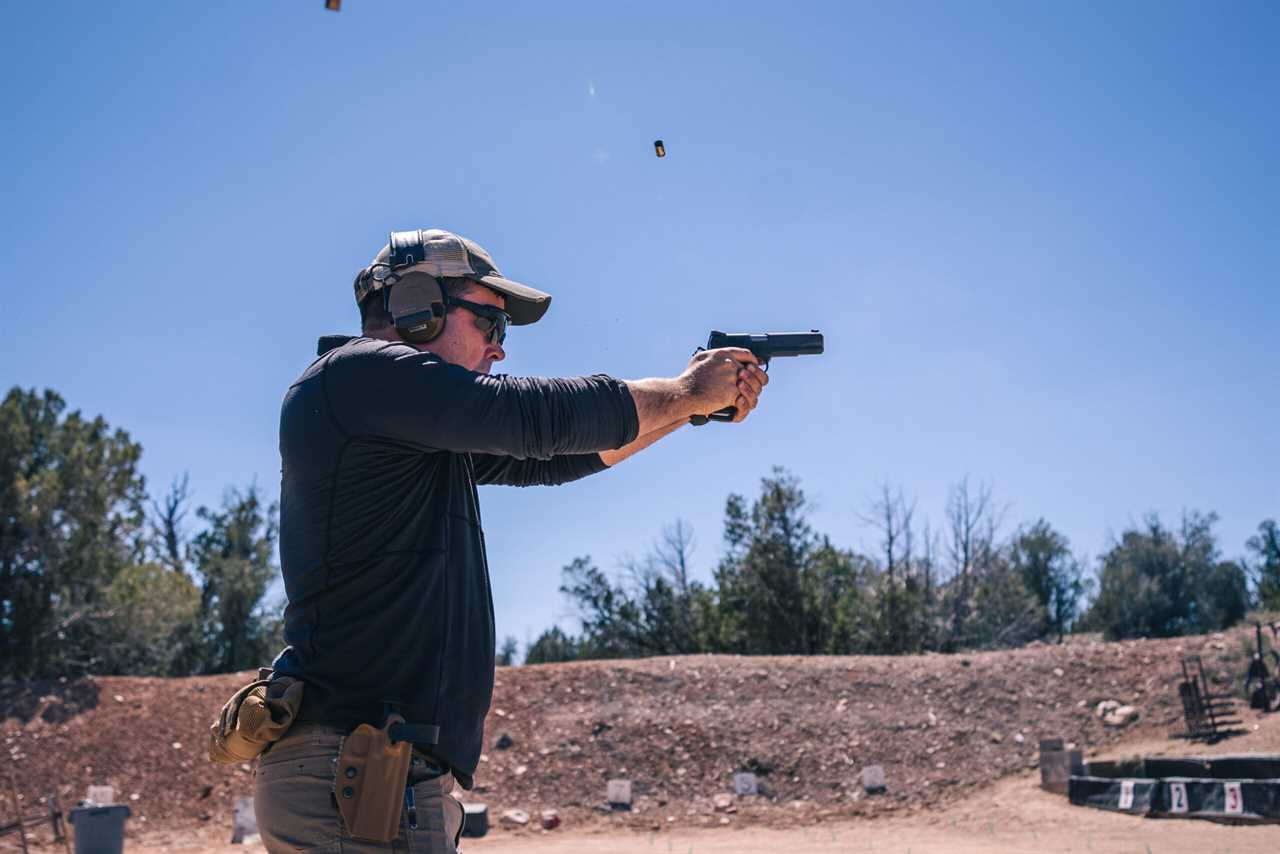
Notice how the shooter maintains his position and aim, even after firing two quick shots. Tanner Denton
Next-Level Pistol accuracy: Shooting from Supported Positions
In competition, you might be restricted to dictated positions, but when possible, you will always be able to shoot more accurately with proper support. If you’re hunting, zeroing your sights or optic, group-testing ammo, working on your trigger control, or seeing how accurate your handgun is, minimizing human input will help you. Supporting your handgun position is simple, and doing it properly will help you shoot more accurately. Here’s how we build a supported handgun-shooting position to test accuracy in our annual handgun test and our roundup of the best 1911’s.
Tools to Build a Supported Position
To build a supported position for shooting a handgun, we use three simple tools: a sturdy tripod, a tac table, and a properly-filled support bag.
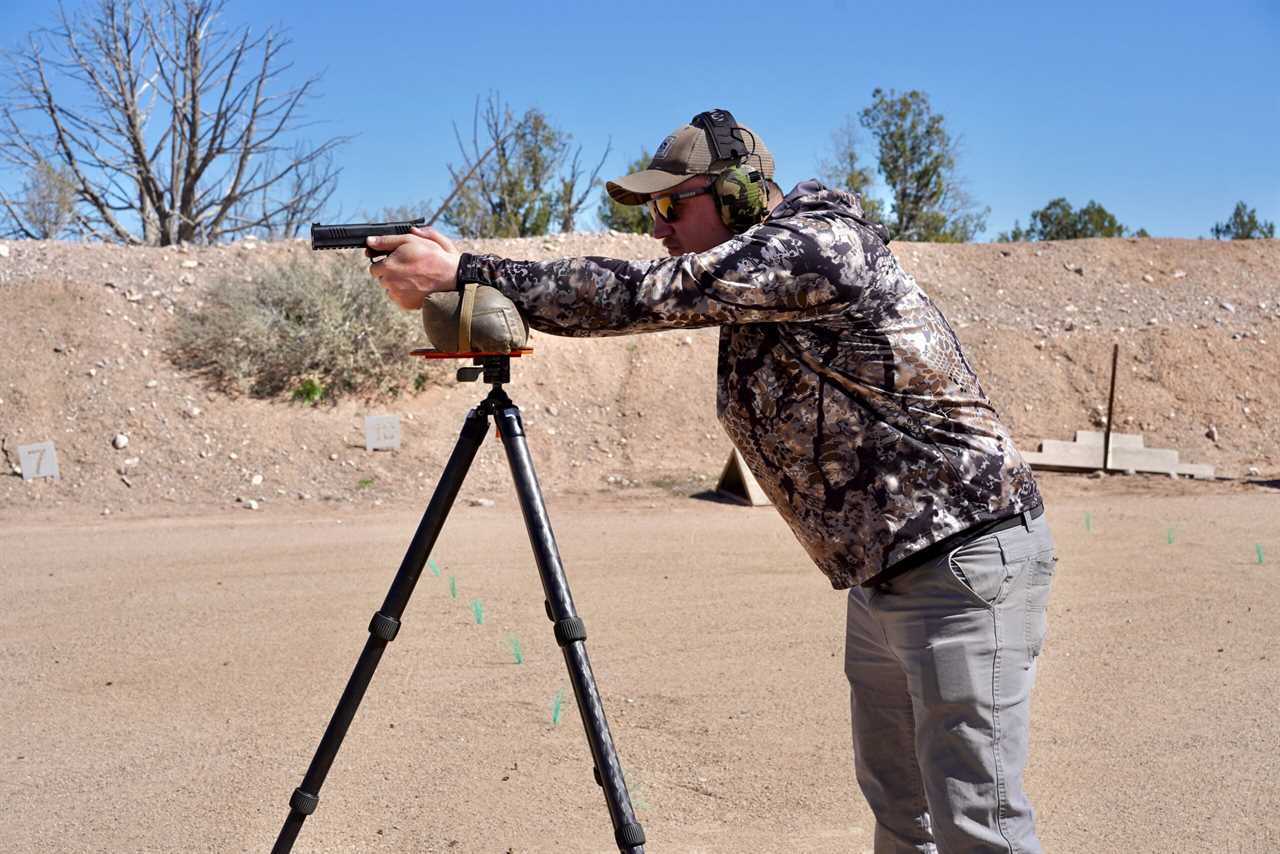
Shooting from a supported position can allow you to shoot a pistol very accurately. Scott Einsmann
The Bag
The bag is the most important tool for a well-supported shooting position. We really like the Game Changer bags from Armageddon Gear. With lightweight fill, these bags are great for both the range and the field. The brand of bag isn’t that important, but you want a bag that isn’t overfilled. You need support, but you don’t want the bag to be too solid. Many off-the-shelf shooting bags are filled to the max and will harden like a rock. Like the kids who’d be behind the school dumpster roasting butts before class would do to their hacky sacks, you’ll want to pull a third or more of the fill out of most shooting bags.
If the bag you have is filled with organic material, it’s a good idea to use a lightweight synthetic filler like Git-Lite, and even airsoft BB’s work in a pinch, but don’t take as solid a set as premium fill does.
The Tripod
Like the shooting bag, the brand of your tripod isn’t critical, but you want a stable one. If you’ve already got something like a Really Right Stuff tripod for your precision rifle or heavy optics, it will work great. You want a tripod that can be adjusted to stand at chest-height, and easy, quick adjustability is a bonus. If you prefer to shoot off a bench or other support, you can forgo the tripod, but for our testing, we want to replicate a natural standing shooting position.
Tac Table
Another handy piece of equipment to shoot a pistol accurately is a tac table that attaches to the top of your tripod. There are a variety of these, and they provide a flat surface atop which you can rest your shooting bag. They aren’t absolutely necessary, and if you’re able to securely rest your bag atop your tripod without it, you can do that. These are handy though, even to carry in the field for a stable rifle or handgun rest while hunting.
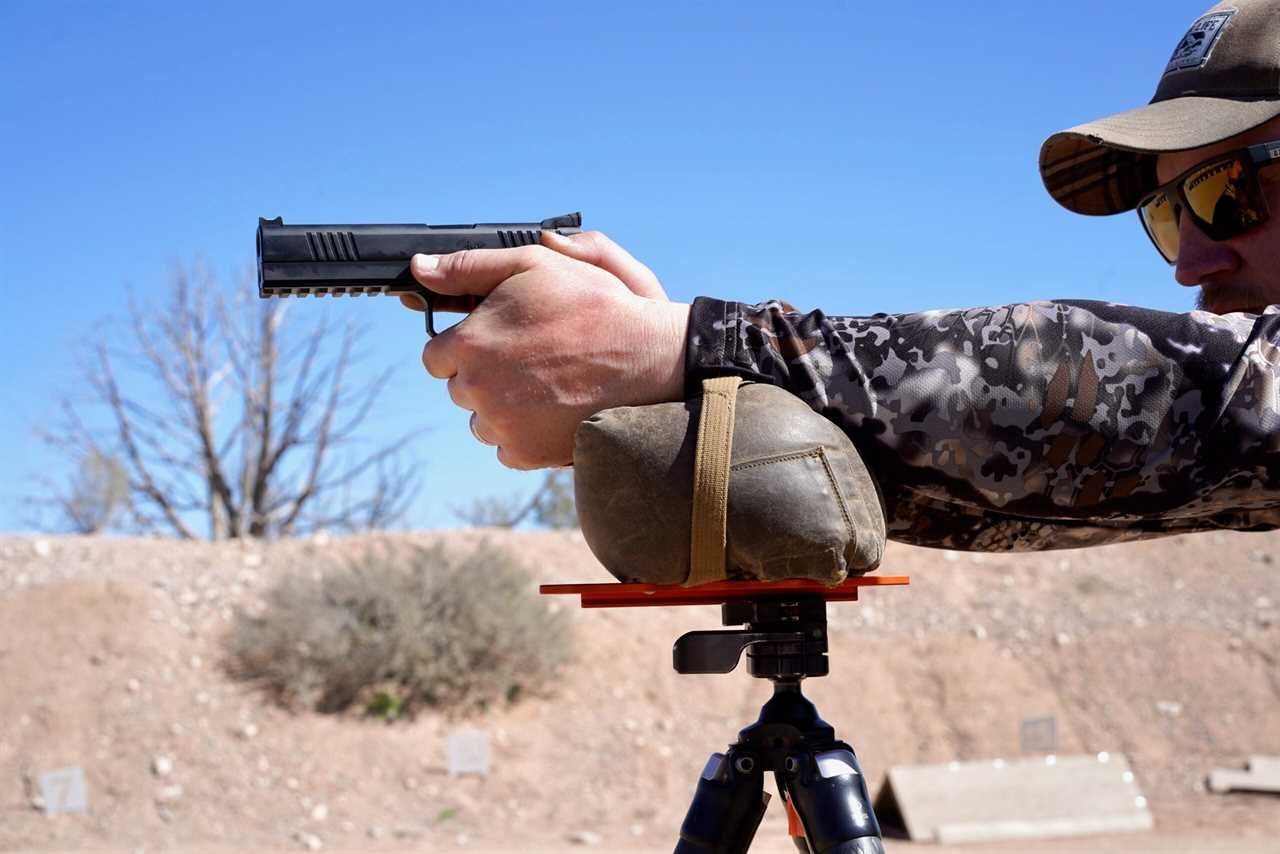
A tripod, tac table, and bag make an excellent rest for pistol shooting. Scott Einsmann
Building Your Position
The goal of using a bag-supported standing position is to replicate how you might shoot without support, and to stabilize the pistol without affecting your grip or the gun’s function. Set the tripod height so that with your hands resting on it, your body will be in a stable shooting position—either exactly as you would shoot free-hand, or slightly lower. Stand back from the tripod far enough that when your arms are extended, your wrists and hands rest comfortably on the bag. It’s ok if you lean forward a bit for added stability, but you don’t want to press too hard on the tripod.
With the pistol in hand, grip it as you normally would, extend your arms, and nestle the butt of the grip and/or your hands and wrists into the bag. Don’t press the gun itself forward into the bag because that can affect its function or tip your tripod. If your tripod is too close and you rest your arms on the bag, with the gun and your hands hanging off the front, you won’t be stable.
How Shooting from Support Can Help Your Accuracy
Like I mentioned before, shooting a pistol accurately means different things in different contexts, but what most of those contexts have in common is a need for fine-tuned and repeatable fundamentals. Shooting from a tripod-and-bag-supported position like this is a great way to both immediately increase your level of precision and work on fundamental shooting skills. With the human element of instability greatly reduced, you can work on all the things we talked about above.
When you can improve your skills in one area, you’ll see a net improvement in your shooting overall. When you learn how to shoot a pistol accurately from a tripod, those skills will carry over to your unsupported shooting too. With improved fundamentals, you can focus on honing your position, speed, and other skills.
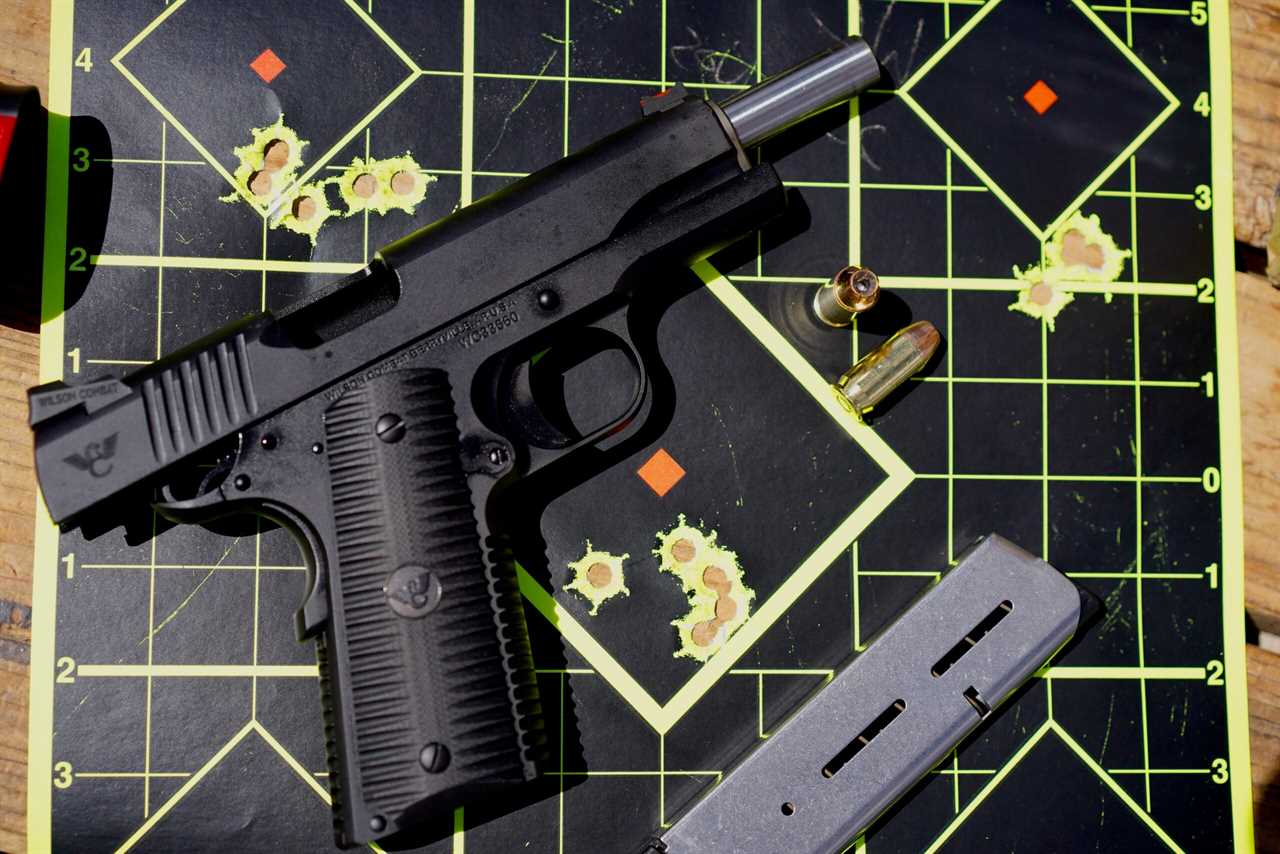
With good fundamentals, you can learn to shoot a pistol accurately. Scott Einsmann
Shooting a Handgun Accurately in the Field
If there’s any single part of this that can help your handgun accuracy more than anything, it’s to build the position where you rest your hands and wrists on a bag while gripping the gun naturally. Tripods are the most convenient tool for doing this, but you’re free to be more creative with it.
This is an excellent way to work on skills, zero pistols, or shoot groups at the range, but taken to the field, it’s great for hunting too. Either while toting a tripod, or just a bag to plop onto a rock, juniper branch, or deadfall, learning to stabilize your shot can help make you a deadly-effective handgun hunter.
The post How to Shoot a Pistol Accurately appeared first on Outdoor Life.
Articles may contain affiliate links which enable us to share in the revenue of any purchases made.
By: Tyler Freel
Title: How to Shoot a Pistol Accurately
Sourced From: www.outdoorlife.com/guns/how-to-shoot-a-pistol-accurately/
Published Date: Thu, 11 May 2023 14:36:21 +0000
----------------------------------------------
 Backyard GrillingWeekend WarriorsAdvice from DadBeard GroomingTV Shows for Guys4x4 Off-Road CarsMens FashionSports NewsAncient Archeology World NewsPrivacy PolicyTerms And Conditions
Backyard GrillingWeekend WarriorsAdvice from DadBeard GroomingTV Shows for Guys4x4 Off-Road CarsMens FashionSports NewsAncient Archeology World NewsPrivacy PolicyTerms And Conditions
